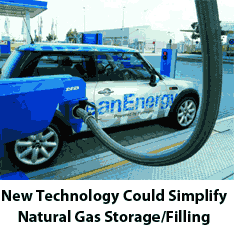Despite much promise for reducing transportation costs and CO2 emissions by moving from traditional diesel fuel to natural gas, the move to nat gas trucks to move freight has been slow, and almost non-existent in the regular consumer auto market. (See Growth of Natural Gas Trucks Not Reaching Levels Many Expected.)
In the trucking sector, there have been a number of factors in that slow growth, including the high premium for natural gas trucks over diesel, a still relative lack of service stations nationwide, and a concern by truckers they won't see potential ROI from the move due to a reduction in current fuel surcharge revenues after the switch.
Part of that extra cost for natural gas powered trucks, and creating a similar burden for consumer autos powered by nat gas, is the complexity of storing natural gas on board, whether that is compressed natural gas (CNG) or the costs to keep liquefied natural gas (LNG) cold.
Now, there is a potential breakthrough in this area that some say could be a game changer.
Chemists at the University of California Berkeley have developed a new porous and flexible material - something called metal-organic framework (MOF) - for storing methane that addresses the exiting problems. The flexible MOF collapses when the methane is extracted to run the engine, but expands when the methane is pumped in at only moderate pressure, within the range produced by a regular home level compressor.
The research on the news approach from Cal Berkley, done in conjunction with National Institute of Standards and Technology and Ford Motor, among others, was published recently in the prestigious academic journal Nature.
The approach could in fact potentially allow consumers to fill up their car's tank at home from a larger storage tank, without needing to stop at a commercial filling station.
The flexible MOF-based tank can be loaded with methane, the main ingredient of natural gas, at 500-900 psi, while CNG vehicles compress natural gas into an empty tank today at 3,600 psi.
Compressing natural gas and then storing it at high pressure requires expensive fueling stations and bulky tanks that take up valuable space in the truck or car.
LNG vehicles operate at lower pressures but require significant insulation in the tank system and equipment to maintain the natural gas at minus 162º C (-260º F) so that it remains liquid.
An emerging alternative to the existing CNG approach is something called adsorbed natural gas (ANG) storage, in which the tank is filled by a porous material with a large amount of surface area. The gas is stored when its molecules somehow adhere to the tank material's surface.
That is the technology the UC Berkley researchers have been developing.
 The challenge was to develop a material that adsorbs gas at the target pressure of 35 atmospheres (roughly 500 psi) but which then also releases all of the gas before the pressure reaches five to six atmospheres, the minimum pressure at which the engine can run. In previously demonstrated systems, too much gas remains stuck in the tank and can't be used, says Jeffrey Long, a UC Berkeley professor of chemistry who led the research. The challenge was to develop a material that adsorbs gas at the target pressure of 35 atmospheres (roughly 500 psi) but which then also releases all of the gas before the pressure reaches five to six atmospheres, the minimum pressure at which the engine can run. In previously demonstrated systems, too much gas remains stuck in the tank and can't be used, says Jeffrey Long, a UC Berkeley professor of chemistry who led the research.
To get around this limitation, the research group used "flexible" metal-organic frameworks that are unlike the rigid ones tried before in ANG systems. The materials expand after a certain pressure is reached, opening their pores to adsorb the gas during fill-up. At a lower pressure, but one slightly higher than the minimum pressure at which the engine runs, the materials collapse and push all the gas out so the engine can use it.
Long noted that "This is a big advance both in terms of capacity and thermal management. With these new flexible MOFs, you can get to capacities beyond what was thought possible with rigid MOFs."
In short, you could use smaller tanks and/or get a lot more miles out of tanks of existing size, and have much simpler and less expensive filling approaches since the natural gas would no longer need to be compressed at high levels.
Long also says that the new type of tank materials would also improve storage of LNG, as it somehow would require lower levels of cooling.
"With our material, some of that heat goes into changing the structure of the material, so you have less heat to dissipate, less heat to manage," Long added. "You don't have to have as much cooling technology associated with filling your tank."
According to Mike Veenstra, from Ford's research and advanced engineering group in Dearborn, Michigan, the company believes that the ANG technology has the potential to lower the cost of on-board tanks, station compressors and fuel along with serving to increase the driving range of natural gas-powered vehicle within the limited cargo space.
While all this sounds very promising, there is a lot of work to do to get it ready for commercialization. It is not clear how long away we are from seeing this new technologies on the road in trucks or cars. Others besides the UC Berkley researchers are working on similar approaches, however.
In the short term though, other approaches will be needed to boost natural gas vehicles sales.
Is storage currently the Achilles Heal of natural gas trucks and cards? Do you see this as a potential breakthough? Let us know your thoughts at the Feedback button below.

|